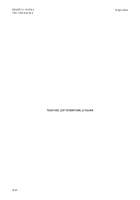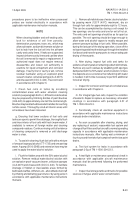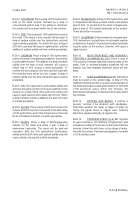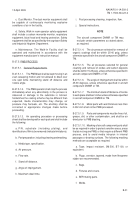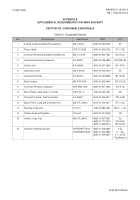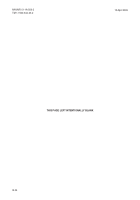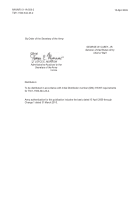TM-1-1500-344-23-2 - Page 231 of 240
B-29
NAVAIR 01-1A-509-2
TM 1-1500-344-23-2
15 April 2009
APPENDIX B
SUPPLEMENTAL REQUIREMENTS FOR ARMY AIRCRAFT
SECTION VII. PLASTIC MEDIA BLASTING (PMB) FOR ARMY AIRCRAFT COMPONENTS
B-27. PLASTIC MEDIA BLASTING (PMB) FOR
ARMY AIRCRAFT COMPONENTS.
B-27.1. SCOPE. The purpose of this section is to
establish the requirements and controls for the PMB
process for use at intermediate and depot level
maintenance of Army aircraft components of rotary
wing aircraft.
B-27.1.1.
Application.
a. This section provides the requirements and
procedures for removing organic coatings (paints,
primers, or lacquers); surface cleaning and removal of
light surface corrosion and carbon deposits; removal of
sealants and adhesives; and assist in removal of any of
these after chemical soaking, from parts and components
of aircraft using PMB techniques.
b. PMB is authorized only for parts and components
where PMB is specified by the applicable aircraft
component Depot Maintenance Work Requirement
(DMWR) or Technical Manual (TM). Comply with any
additional processing instructions required by these
authorizing documents. The applicable technical data
shall be used when additional processing, such as
etching to remove metal flow, flushing, solvent cleaning,
stripping, etc., is used in conjunction with the PMB
processing.
c. Request for processing Flight Safety Parts (FSP)
with internal oil, grease, air, or other fluid passages, will
be coordinated and approved via official written
correspondence by the AMCOM Aviation and Missile
Research Development Engineering Center (AMRDEC)
before authorizing PMB.
d. For purposes of this section, PMB shall be used
on metal surfaces and the following composite surfaces
only: fiberglass, carbon fiber, boron and graphite/epoxy,
and Kevlar. Proper masking shall be in place where
other types of surfaces are present.
B-27.1.2.
Limitations. The PMB shall not be authorized
for the following surfaces:
a. Engineering plastics and glass that must remain
clear.
b. Elastomeric rubber surfaces.
c. Cadmium plated parts and other plated or
contaminated parts where the PMB may generate
airborne hazards controlled by safety, health, or
environmental regulations.
d. Parts made of Beryllium Copper.
e. Bearings and assemblies with exposed seals and
gaskets unless these can be properly masked and post
examination reveals zero intrusion of media in active or
lube wetted surfaces.
f. Teflon lined surfaces and small threaded holes
and inserts.
B-27.1.3.
Classification.
B-27.1.3.1.
Critical Parts. Parts with Internal air or
fluid flow passages, or FSP where any portion of the
PMB is considered a Critical Inspection Point.
B-27.1.3.2.
Soft Metal Parts. Parts made of Aluminum
or Magnesium Alloy.
B-27.1.3.3.
Ferrous Parts. Parts made of Ferrous
Alloy.
B-27.1.3.4.
Titanium Parts. Parts made of Titanium
Alloy.
B-27.1.3.5.
Non-metal Parts. Non-metal parts or
surfaces approved for PMB.
B-27.2. DOCUMENT CONFLICTS. In event of conflict
between the requirements
of this section and the
applicable aircraft component DMWR or TM, the aircraft
component DMWR or TM shall take precedence. The
requirements of this section shall take precedence over
any other specifications or standards referenced herein.
B-27.3. MATERIAL REQUIREMENTS.
B-27.3.1. The plastic media type used for the PMB
process shall be in accordance with MIL-P-85891
Type V, 20-40 particle size. Optional media and particle
size is not authorized unless approved by the aircraft
component DMWR or TM.
Back to Top


